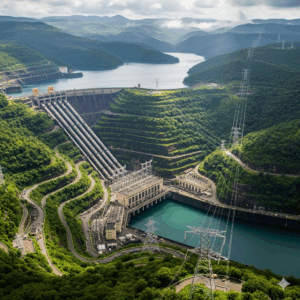
Gerusoppa Storage Pumped Sharavati
Public Grievance Meeting in Gerusoppa Today
Is the Sharavathi Pumped Storage Project a Step Towards Energy Security or a Prelude to Environmental Instability?
Konkanavahini News, Karwar: A public grievance meeting regarding the Sharavathi Pumped Storage Project is set to take place today in Gerusoppa, Honnavar Taluk, which will determine the project’s fate. A similar meeting in Shivamogga district has already seen widespread opposition to the project.
The increasing demand for electricity in Karnataka is undeniable, driven by industrial growth, urbanization, and modern lifestyles. Due to the instability of renewable energy sources like solar and wind, the government is promoting the “pumped storage project” as a modern solution for energy management, which stores excess power generated from these sources for use during high-demand periods. The proposal to implement this project near the Sharavathi River has sparked intense debate. However, the associated environmental damages cannot be ignored.
Proponents argue that the project promises energy stability by storing excess power from solar and wind energy for release during peak demand, thus addressing power shortages. They claim it will ensure continuous supply to industries and stable electricity for rural areas, along with creating job opportunities for locals. It is also seen as an environmentally friendly alternative by reducing reliance on coal and other fossil fuels.

However, the harsh truth behind this appealing picture cannot be overlooked. The project would require the destruction of vast forest areas in the Western Ghats, a UNESCO-recognized biodiversity hotspot, threatening many rare species of flora and fauna. Additionally, local villagers may face displacement and loss of livelihoods, leading to social unrest. Altering the natural flow of the Sharavathi River could devastate downstream agricultural activities and lead to drinking water shortages. Aquatic life, including fish, could face severe challenges.
Experts warn that the dam, tunnels, and land alterations involved in the pumped storage project could trigger landslides and earthquakes. Soil erosion, artificial sediment accumulation in rivers, and increased carbon emissions from deforestation could contribute to climate change. Thus, this project, labeled as “environmentally friendly,” might actually exacerbate climate change in the Western Ghats.
While development is necessary, it should not come at the cost of nature. A precise answer is needed to determine whether the Sharavathi Pumped Storage Project is truly a solution for energy security or a prelude to environmental instability. Public consultation, transparent environmental assessments, and serious consideration of alternative approaches are essential. Decisions made today to address power shortages should not harm nature and burden future generations, as that cannot be called development.
Sharavathi Pumped Storage Project – Benefits, Drawbacks, and Environmental Impact
Amidst the growing energy needs of Karnataka, discussions are intensifying about implementing a pumped storage project near the Sharavathi River. While this project employs modern technology for power generation, offering several benefits, there are concerns about its harmful environmental impacts.
Project Benefits
1. Support for Renewable Energy: Renewable sources like solar and wind are intermittent. The Sharavathi Pumped Storage Project helps store excess power from these sources for release during high demand.
2. Power Stability: It aids in reducing the supply-demand gap, providing continuous and stable electricity to the state.
3. Economic Development: The project could create job opportunities for locals and reduce power shortages in the industrial sector.
4. Modern Technology: As an environmentally friendly alternative, it could help reduce reliance on coal and oil.
Project Drawbacks
1. Deforestation: The project would require clearing large forest areas, threatening wildlife habitats and biodiversity.
2. Displacement: Villagers may need to be relocated, leading to social and economic dissatisfaction.
3. Harm to Aquatic Life: Altering the natural flow of the Sharavathi River could adversely affect aquatic life, including fish.
4. Earthquakes and Landslides: The construction of dams and geological changes could increase the risk of earthquakes or landslides.
Environmental Impact
The area surrounding the Sharavathi dam is the heart of the Western Ghats’ biodiversity. The forests here are home to rare flora and fauna. If deforestation occurs for the pumped storage project:
• Biodiversity Loss: Rare birds, wildlife, and plant species face extinction risks.
• Water Cycle Instability: Changes in river flow could disrupt downstream agriculture and drinking water systems.
• Climate Change: Deforestation could increase carbon emissions, raising local temperatures.
• Soil Degradation: Increased surface soil erosion and sediment accumulation in rivers.
















